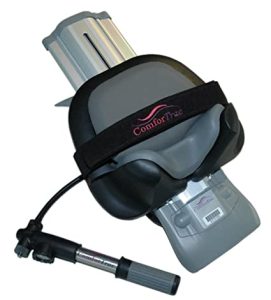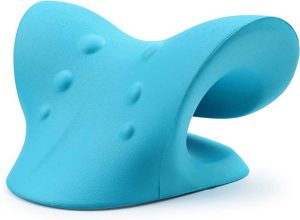Best Occipital Release Tool/Device & Pillow for Massage
Neck pain is a common issue that can be caused by a variety of factors, including poor posture, muscle tension, and injuries. The occipital muscles are located at the base of the skull, and they can become tight and painful due to stress or strain. Fortunately, there are a number of occipital release tools and devices that can help to relieve the pain and tension.
One of the best occipital release tools on the market is the TheraBand foam roller. This device is specifically designed to massage and stretch the muscles at the back of the head and neck. It includes a built-in pressure point massager that can help to loosen knots and trigger points. The foam roller is also available in different sizes to accommodate different needs.
Another great option is the Body Back Buddy trigger point massager. This device features 11 different massage heads that can target specific muscle groups. It also has an ergonomic design that makes it easy to use on your own or with a partner. The Body Back Buddy is an excellent choice for people who suffer from frequent neck pain.
If you are looking for a more affordable option, the Acuforce 3.0 therapeutic massage ball is a great choice. This ball is specifically designed to target trigger points and knots. It is made from high-quality materials, and it is small enough to carry with you wherever you go. The Acuforce 3.0 is an ideal option for people who want an effective massage ball that doesn’t cost a lot of money. No matter what your budget is, there is an occipital release tool that can help you get relief from neck pain.
Factors to consider before purchasing Occipital Release Tool/Device
1. The type of device that you need
There are a few different types of Occipital Release Devices on the market, so it’s important to choose the one that is best suited for your needs. If you have mild to moderate headaches, then a simple device that applies pressure to the back of the head may be all you need. However, if you suffer from more severe headaches, then you may need a device that also applies pressure to the temples or forehead.
2. The size of the device
Another factor to consider is the size of the device. Some devices are designed to be worn all day, while others are only meant to be worn for short periods of time. If you plan on wearing the device all day, then you will need to make sure that it is comfortable and does not cause any pain or discomfort.
3. The price of the device
Of course, price is always a factor to consider when making any purchase. Occipital Release Devices range in price from around $30 to $200, so it’s important to find one that fits within your budget. It’s also important to keep in mind that cheaper devices may not be as effective as more expensive ones.
4. Reviews of the device
Before making any purchase, it’s always a good idea to read reviews of the product. This will give you an idea of what other people have thought about the device and whether or not they would recommend it. You can find reviews of Occipital Release Devices online or in magazines
1. The Cervical traction device by ComforTrac

It is a great option for those looking for an occipital release device. The device is FDA-cleared and can be used at home or in the office. It comes with a carrying case and instructions, and can be adjusted to fit most head sizes.
2. The Occipital Release Device by Bodymate

This is another great option for those looking for an occipital release device. The device is made from high-quality materials and is adjustable to fit most head sizes. It comes with a carrying case and instructions, and can be used at home or in the office.
3. The Headache Relief Kit by Nerve Pain Solutions

This kit is a great option for those looking for an occipital release device. The kit includes an occipital release device, a cold pack, and a heat pack. It also comes with a carrying case and instructions.
4. The migraine relief kit by Nerve Pain Solutions

It is another great option for those looking for an occipital release device. The kit includes an occipital release device, a cold pack, and a heat pack. It also comes with earplugs, a sleep mask, and instructions.
FAQ’s
How do you release the occipital muscle?
Releasing the occipital muscle is an important step in relieving tension and reducing muscle tightness in the head, neck, and shoulders. Since this muscle is often overused due to stress or poor posture, it can become tight and painful if not released properly. One effective way to release the occipital muscle is by using a foam roller. To do this, you will want to lie on your back on a flat surface with a foam roller placed underneath your head. Gently roll the roller up and down, from the base of your skull all the way to just below your ears. As you do this, make sure to focus on any areas that feel particularly tight or sore– these are usually the spots needing attention. Additionally, once you are done rolling back and forth along your head, try rotating your head gently from side to side while continuing to apply pressure with the foam roller for further release.
Another technique for releasing the occipital muscle is through self-massage techniques using thumbs or knuckles. Begin by placing your hands at either side of your head and applying gentle pressure along either side of the neck muscles until you feel tension release. You can also create circles with moderate pressure as if “kneading” dough between both hands around the sides of your neck for further relaxation of these muscles. Finally, finish off with some light tapping motions around the neck until tension has been completely relieved from this area. Both techniques should help reduce any discomfort caused by tightness in this muscle group while promoting better posture and improved range of motion in both neck and shoulder movements.
How do you do a Suboccipital release at home?
A Suboccipital release is a technique used to reduce pain and tension in the neck and head region, typically done by massage therapists or physical therapists. However, it can also be performed at home with a few simple steps.
To perform a suboccipital release at home, begin by lying on your back on a flat surface such as the floor or a bed. Place two fingers of one hand on either side of the back of the head, just above where it meets the neck. Firmly but gently apply pressure outward for 30-60 seconds. You should feel a gentle stretching sensation in the muscles surrounding your skull as you do this. Once you’ve finished holding this position, slowly rotate your head in circles to each side several times while maintaining pressure with your fingers.
Next, gently press upward and backward onto the base of your skull using both thumbs for 20-30 seconds before releasing and giving your head another rotation in each direction. Repeat this process several times until you feel any tightness in the area has been released. Lastly, finish up with some gentle massage strokes along both sides of the neck and into the upper shoulder area for about 30 seconds to help relax any remaining tension in the muscles surrounding your neck.
By performing this suboccipital release technique regularly at home, you can help reduce pain and tension in your neck and shoulders caused by poor posture, stress or even exercise that may be causing muscular stiffness or pain around this area of your body. Remember to always use caution when performing any self-massage technique as overworking an already sore muscle can lead to more serious issues such as strains or tears if not done properly!
How long hold occipital release?
Typically, occipital release should be held for approximately 20 seconds. When performing the occipital release technique, the patient should lie down on their back with their head supported and slightly elevated. The practitioner should then place the tips of their index and middle fingers on either side of the mastoid process, which is located at the base of skull just below the ears. From there, they will apply a gentle pressure in an upward and backward direction as they hold for 20 seconds. It’s important to note that during this technique, no jerking or bouncing motions should be used as this could cause further injury. While holding this pressure for 20 seconds, it is beneficial for both the patient and practitioner to take deep breaths in order to stay present in the moment. This can also help to relax any muscle tension in the neck or head region that may be causing discomfort or stiffness in these areas. After holding this pressure for 20 seconds, they will repeat it two more times before ending with a final longer hold of 30-45 seconds. This technique can help to release tension from tight muscles in the neck and shoulder area which can lead to improved mobility and range of motion throughout these regions.
Does the neck release tool work?
The neck release tool is a device designed to help reduce tension and pain in the neck. It works by using gentle pressure to provide deep tissue massage, which helps reduce tension in the muscles. This type of massage also helps improve circulation and range of motion in the neck, allowing for improved flexibility and reduced pain. The device is easy to use and fits comfortably around the neck; it even comes with adjustable straps so you can find the perfect fit for your needs.
So does it work? According to reviews from customers who have tried the neck release tool, its effectiveness has been noted time and time again. Users report a reduction in tension, an improvement in range of motion, and improved comfort within just a few minutes after using the device. Additionally, many users note that they’ve been able to resolve chronic neck pain with regular use of the device over time. So while no device will work perfectly for everyone, there is certainly evidence that this one can bring relief to those suffering from neck pain or stiffness.
How do you loosen tight muscles at the base of the skull?
There are a number of ways to loosen tight muscles at the base of the skull. One is to use a tennis ball or other small, firm object to massage the muscles. Another is to do gentle stretching exercises. Hold your head in your hands and slowly tilt it forward, then to the left and right. You can also try lying down on your back and placing a pillow under your head. Gently turn your head from side to side. These exercises should help to loosen the muscles and relieve the pain. If the pain persists, however, you should see a doctor to rule out any other potential causes.
How do you release occipital trigger points?
There are a few different ways that you can release your occipital trigger points. One method is to use a tennis ball. Simply place the ball at the base of your skull and apply pressure. You can also use your thumb or index finger to massage the area. Another option is to stretch the muscles in your neck. You can do this by tilting your head back and forth or side to side. If you’re looking for a more long-term solution, you can try dry needling. This involves insert thin needles into the muscle in order to release the tension. Whichever method you choose, make sure to listen to your body and stop if you start to feel pain.
Can you massage the occipital nerve?
The Occipital nerves are a pair of nerves that run from the base of the skull to the back of the head. Though often ignored, these nerves play an important role in sensations of touch and pain. As a result, it’s not uncommon for people to experience pain and discomfort in this area. Massaging the Occipital nerves can help to relieve some of this pain and tension. To do this, simply place your fingers on either side of the back of your head and gently rub in a circular motion. You may also want to use a gentle pressure to apply pressure to the Occipital nerves. If you’re feeling particularly tight, you can also try using a tennis ball or lacrosse ball to massage the area. Remember to be gentle, as too much pressure can actually aggravate the Occipital nerves.
Can tight neck muscles cause occipital neuralgia?
The causes of occipital neuralgia are not fully understood. However, some experts believe that tight neck muscles may contribute to the condition. Occipital neuralgia is a type of headache that is caused by the compression or irritation of the occipital nerves. These nerves are located at the back of the head and provide sensation to the scalp. The symptoms of occipital neuralgia can vary widely, but they typically include sharp, shooting pain in the back of the head and neck. The pain may be worse when moving the head or lying down, and it can often be accompanied by tenderness in the affected area. While the exact cause of occipital neuralgia is unknown, it is believed to be associated with certain underlying medical conditions, such as migraine headaches, pinched nerves, and arthritis. Tight neck muscles may contribute to these conditions and, as a result, may also play a role in occipital neuralgia. If you think you may be suffering from occipital neuralgia, it is important to see a doctor for an accurate diagnosis and treatment plan.
Can cracking your neck cause occipital neuralgia?
Some experts believe that neck cracking can lead to a misalignment of the vertebrae, which in turn can cause pressure on the nerves. This pressure may then result in occipital neuralgia, a condition characterized by throbbing pain in the head and neck. If you experience any pain or discomfort after cracking your neck, it is important to see a doctor to rule out any underlying issues. In general, it is best to avoid neck cracking, as it can potentially lead to other problems.
Can you give yourself a neck adjustment?
It is possible to slightly manipulate the vertebrae in your neck, doing so can be extremely dangerous. The neck is a fragile part of the body, and even a small mistake can cause serious injury. That’s why it’s always best to leave neck adjustments to trained professionals. Chiropractors, for example, undergo years of training to learn how to safely adjust the spine. So if you’re experiencing neck pain, make an appointment with a chiropractor instead of trying to adjust your own neck. It might not be as satisfying as doing it yourself, but it’s definitely the safer option.